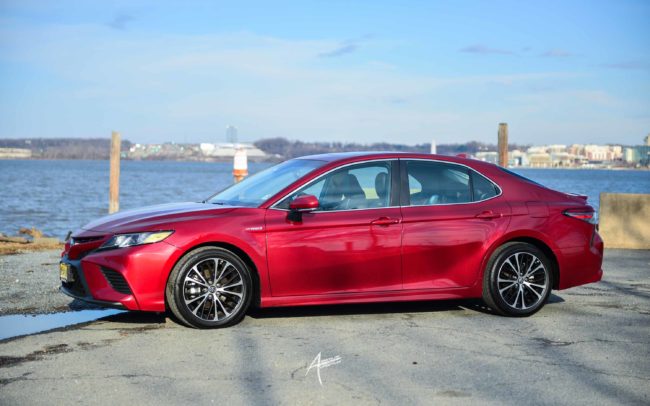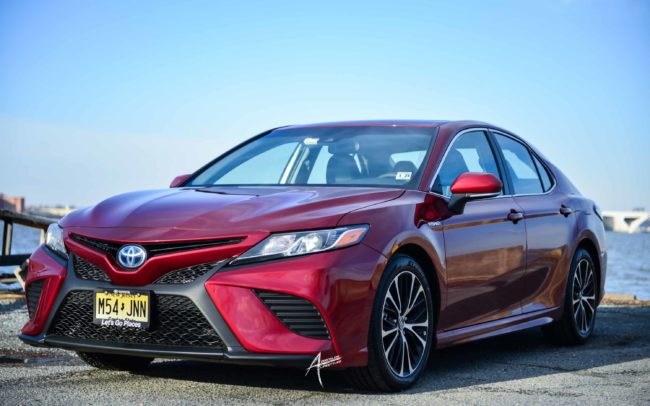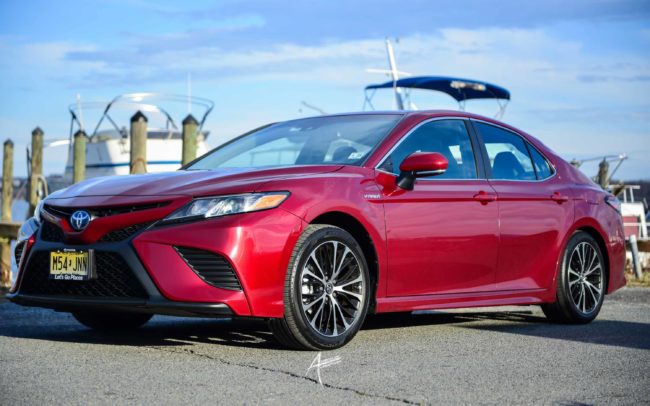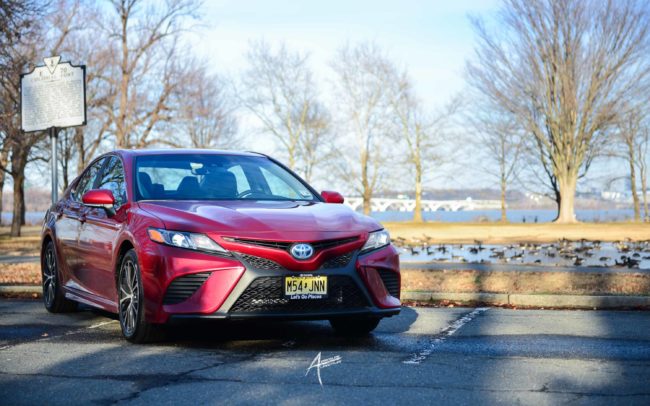
Experienced by Adrian McQueen
Photography by Adrenaline Lifestyles
It had been some time since I was able to test out the all-new 2018 Toyota Camry at the WAPA Ride and Drive event, so to get this extended opportunity with the Camry was exciting. This week was set to be full of a lot more driving than I typically do. I live in the Washington DC area and I was scheduled to cover two automotive events in Baltimore region. How lucky was I to have the Ruby Flare Pearl hue 2018 Toyota Camry Hybrid SE dropped off in my driveway. The Camry has kept a great reputation as being one of the most reliable cars on the market, so I was excited to get the chance to experience the new redesigned model.
I have seen the Camry change so much over years, since it was known as the Celica Camry, but for 2018 this is most sporty design to date. Upon first look I was impressed by Toyota’s midsize sedan. Built on Toyota’s New Global Architecture (TNGA), the Camry is lower and wider than the outgoing model, with about a 2-inch-longer wheelbase. TNGA also features a new fully independent suspension design with control arm rear suspension at the rear. TNGA has also placed the Camry Hybrid’s batteries under the rear seats, which gives it the same 15.1-cubic-foot trunk as the gas-only versions and it can be expanded 60/40 split-folding rear seats.
Unfortunately, this move has made the Camry a bit smaller on the inside, losing rear legroom and shoulder room. It was still a comfortable ride and fit for me. The driving position is roomy and I had plenty of headroom. The Camry Hybrid SE comes with 18-inch alloy wheels, leatherette upholstery, a rear spoiler and a Sport mode for the drive mode selector. I love how the redesign is sportier looking and more engaging to drive than in past years.
The Camry SE employs the older nickel-metal-hydride (NiMH) battery technology and come in at 44/47 mpg city/highway. My trips to the Timonium Motorcycle show at the Maryland State Fairgrounds, also sponsored by Toyota, slowly moved the needle. Driving mostly in Eco mode, I sacrificed the throttle response. Coasting saves energy as well as light accelerating. Camry’s redesigned seats are distinctively shaped with available leather trim and contrast stitching. Camry’s available steering wheel-mounted paddle shifters give you the power to shift gears manually for a more controlled experience.
After a weekend full of rain, I was able to get out for a photo session with the Camry. My route had an alluring landscape and overlooked the Potomac river. The drive covered some of most picturesque views that the Washington DC area. The country setting, river view and winding roads, were the perfect elements for me to enjoy the seat time with the Camry. The Camry’s newly-developed 2.5-liter Dynamic Force 4-cylinder engine kicks out around 206 horsepower. This surely attributed to the sharp steering and crisp cornering of the Camry on the route. Going in and out of the corners, I felt the balance was good and the ride was comfortable. Toyota has improved the steering and the braking to the ride and handling of the Camry.
Our SE hybrid was further enhanced with a sunroof and adaptive headlights. I was impressed by the standard 7-inch touch screen and Toyota’s Entune 3.0 infotainment system. There is built-in navigation as well as the ability to tap into the users’ phone thru Toyota’s app suite. Unfortunately, Android Auto and Apple CarPlay are not supported. The controls were user friendly with great touch response. The SE model Camry did not have the JBL 800-watt, nine-speaker JBL sound system that I fell in love with during the launch event but the system provided sufficed. Road and wind noise seemed quiet inside the Camry cabin.
The Camry comes equipped with ten airbags and the Toyota Safety Sense P system, that is standard on all models. This includes forward-collision warning, automatic emergency braking, pedestrian detection, lane departure assist, hill-start assist, auto high-beams, and dynamic radar cruise control. Blind-spot warning and rear cross-traffic warning come standard on the top XSE and XLE trims but are optional on all other models, except the base L. Drive Start Control prevents the car from jumping forward or backward if the shifter is moved while the accelerator is accidentally depressed. I am confident in stating that Toyota has covered all bases in the safety department.
Camry now has the Bird’s Eye View Camera with Perimeter Scan. The Intelligent Clearance Sonar (ICS) helps you navigate around hidden obstacles. Remote Connect allows you to stay connected with your Camry even if you are not around it. It also has innovative features such as locating your vehicle in a crowded lot or monitoring guest drivers.
The Camry Hybrid SE model we tested comes in at $34,513.00. The key competitors of the Camry are the Ford Fusion Hybrid, Honda Accord Hybrid, Kia Optima Hybrid and the Hyundai Sonata Hybrid. The Camry Hybrid is above the more compact Prius hatchback and the Prius Prime plug-in hybrid but falls under larger Avalon sedan. The Camry Hybrid SE doesn’t have as much power as the available V-6 engine, but it still offers plenty of power, especially in Sport mode. Toyota is really sitting on the throne as the king of the midsized sedan. Enjoy the photo gallery.







